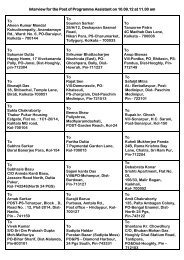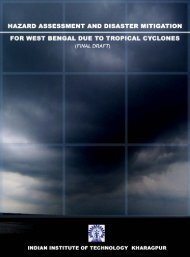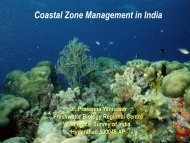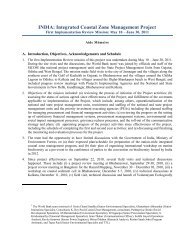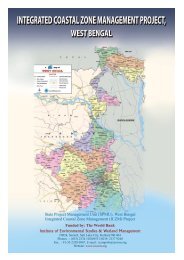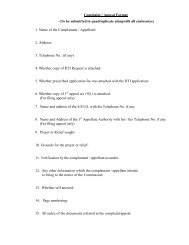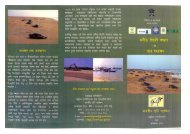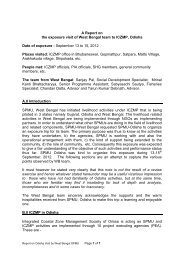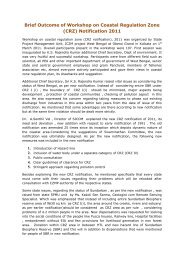BID Document for Guest House with Boundary Wall.pdf - Integrated ...
BID Document for Guest House with Boundary Wall.pdf - Integrated ...
BID Document for Guest House with Boundary Wall.pdf - Integrated ...
You also want an ePaper? Increase the reach of your titles
YUMPU automatically turns print PDFs into web optimized ePapers that Google loves.
All valves shall be provided <strong>with</strong> cap / hand lever / hand wheel as required <strong>with</strong>in easy reach. Wherever<br />
necessary operating plat<strong>for</strong>ms shall be provided. In general, valves installed underground shall have caps and<br />
those fitted above ground shall be operable by hand wheels.<br />
4.0 Bends And Fittings<br />
Pipelines shall be laid in straight lines <strong>with</strong> gradual changes being taken up at the joints as approved by the<br />
manufacturers / and or relevant IS code as desired E.I.C. Where a sudden change of direction cannot be<br />
avoided bends shall be used. The location of bends tees, and other fittings shall be determined in the field in<br />
close cooperation <strong>with</strong> the Engineer-In-Charge.<br />
5.0 Blind Ends<br />
All pipe ends that shall be connected to future extensions, plugs, caps or blank flanges shall be installed and<br />
secured in place.<br />
6.0 Valve Chambers<br />
Valves on an underground pipeline shall be located in a Masonry chamber <strong>with</strong> Pre cast RCC slab in three<br />
pieces consisting of edge protection M.S. structural angle L40 x 40 x 6 mm weighing not less than 3.50 kg/m,<br />
fitted & fixed along the all corners <strong>with</strong> necessary welding of the angles and rein<strong>for</strong>cement steel as per<br />
approved drawing and direction of the Engineer-In-Charge.<br />
7.0 Existing Road Crossing<br />
The Contractor shall programmed the work to reduce disruption to road traffic to a minimum, and be<strong>for</strong>e any<br />
work commences in existing roads shall:<br />
i) Obtain full permission and approval of EIC, serving notice of intent to start work as may be<br />
necessary and observing all the Project area rules and regulations.<br />
ii) Submit details of his proposals, and obtain approval from the Engineer-In-Charge.<br />
iii) Suitable signs indicating that a street is closed and suitable detour signs <strong>for</strong> proper maintenance to<br />
traffic shall be provided.<br />
iv) Wherever necessary contractor shall make alternate routes <strong>for</strong> Project work’s traffic diversion as<br />
directed by the concerned authority.<br />
v) The bedding <strong>for</strong> the pipelines to be laid under the road crossing shall be in accordance <strong>with</strong> the<br />
relevant drawings as per direction of the Engineer-In-Charge.<br />
vi) The road way shall be reinstated to the satisfaction of EIC.<br />
8.0 Hydraulic Testing:<br />
Hydraulic Testing of Ductile Iron/MS/CI pipes:<br />
All pipelines and all works shall be subject to pressure and leakage tests after being laid and installed be<strong>for</strong>e<br />
commissioning.<br />
Pressure and leakage tests shall be carried out simultaneously.<br />
Provisions of this clause shall be read in conjunction <strong>with</strong> the provisions <strong>for</strong> testing of pipes under IS: 3114,<br />
IS: 12288 & IS: 5822 and other Indian Standard Specifications as applicable.<br />
The field test pressure to be applied shall not be less than the greatest of the following subject to a maximum<br />
limit of field hydrostatic test pressure as per IS:12288:1987, IS:3114 & IS:5822 and other Indian Standard<br />
Specifications as applicable.<br />
(i) Maximum sustained operating pressure<br />
(ii) Maximum static pressure plus 5 N/mm 2<br />
(iii) Sum of the maximum sustained operating pressure (or the maximum static pressure) and the<br />
maximum calculated surge pressure.<br />
The pipeline shall be filled slowly from the lowest point in such a manner as to allow expulsion of air through<br />
air release valves at highest points. The following filling rates are recommended:<br />
Size, mm: 100 150 200 250 300 400 500 600 700 800 900 1000<br />
Filling rate,<br />
Ltr/sec 0.3 0.7 2.5 2.0 3.0 6.0 9.0 14.0 19.0 25.0 32.0 40.0<br />
After filling, the pipeline shall be pressurized to the specified operating pressure and left <strong>for</strong> a period of time<br />
to achieve stable conditions. The pipeline shall then be pressurized up to the full test pressure and the section<br />
under test completely closed off. Care shall be taken to ensure that the pipeline is free of air. For this,<br />
89






